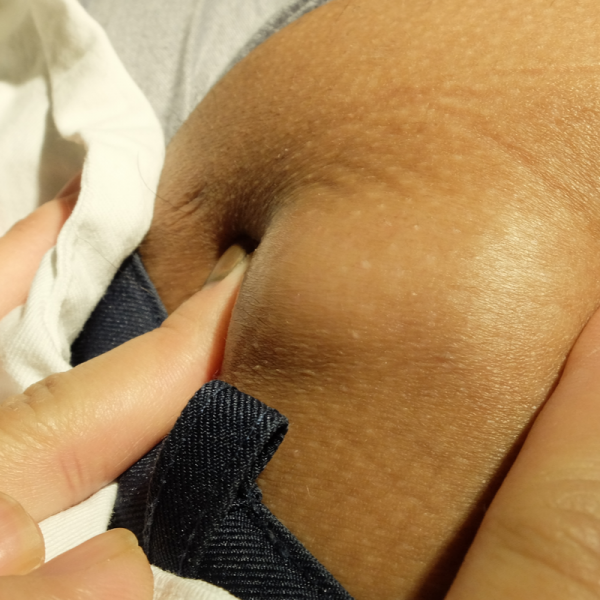
What is a fibroma?
A fibroma is the new formation of connective tissue in which various growths occur due to certain connective tissue cells (so-called fibrocytes). Fibromas are small benign tumours.
What forms of fibromas are distinguished?
Fibromas are divided into the following forms:
- Soft fibroma (fibroma molle or fibroma pendulans):
- these are small, skin-coloured tumours which can occur in both women and men, but which affect overweight people more than average. Soft fibromas often form for the first time during puberty as skin protrusions a few millimetres in size. Because of their appearance, soft fibromas are also colloquially called stalked warts, as they hang like a little bag from a narrow base. Soft fibroids usually form on the neck, armpits and groin. They can occur singly or in multiples.
- Hard fibroma (histiocytoma or dermatofibroma):
- occur particularly frequently on the legs, but also on the arms or in the trunk area. The majority of all adults have at least one hard fibroma, which appears as a darker to light brown nodule a few millimetres in size on the skin. Young women are more likely than average to develop a hard fibroma on their legs.
- Irritation fibroma:
- this is a fibroma of the mucous membrane of the mouth, which occurs especially when there are recurrent irritated areas in the mouth. This includes mainly the cheek area, but also the gums or the skin area at the side of the tongue. An irritant fibroma is a small, smooth and limited nodule that is the same colour as the surrounding tissue or slightly lighter.
Bone fibromas, which are rather rare but form tumours, can be divided into the following subtypes:
- Ossifying fibroma: this is a rare, benign tumour of the facial skull. It usually occurs in the lower jaw bone.
- Non-ossifying fibroma (cortical defect): is a pathological change in the connective tissue of the bone, which in some cases children develop.
- Chondromyxoid fibroma: usually occurs in long tubular bones and primarily affects adolescents.
- Desmoplastic fibroma: describes an aggressively growing bone tumour that mainly affects young people.
- Angiofibroma: is located in the nasopharynx, has many vessels running through it and occurs almost exclusively in male adolescents.
What are the causes of fibromas?
In most cases, the causes of fibromas are still unknown. Soft fibromas, which belong to the group of harmartomas, can develop due to a defect in the embryonic germinal tissue, from which various tissue forms (so-called differentiations) can develop over time.
Furthermore, individual diseases have the reputation of contributing to the formation of hamartomas. These include Cowden's syndrome, for example, but also neurofibromatosis type 1 (Recklinghausen's disease). Hereditary factors therefore play a central role in the development of a fibroma.
Hard fibromas, on the other hand, affect patients with systemic lupus erythematosus as well as the immunodeficiency AIDS and/or an immune system that is suppressed by medication, for example after a transplant, more frequently than average. Doctors assume that hard fibromas can form as a result of small inflammations of the connective tissue, such as after insect bites, plant thorns or the inflammation of a hair follicle (foliculitis).
What are the symptoms of a fibroma?
A fibroma is visible on the outside of the skin, but usually does not cause pain unless it is injured. As a soft fibroma, it can take on a pedunculated shape or form small wrinkles on the surface if it is a large growth. As a rule, the majority of all fibromas are skin-coloured. If you try to turn them, they take on a red to black colour due to the injury of the blood vessels. Hard fibromas, on the other hand, tend to have a somewhat darker to greyish-brown colour shade and are either slightly raised or sunken in relation to the skin surface. Hard fibromas are characterised by their typical Fitzpatrick sign: If you squeeze the area around the hard fibroma with your thumb and index finger, it sinks into the skin.
How is a fibroma diagnosed?
Fibromas are diagnosed by a dermatologist. If it is a typical fibroma, it can be seen at first glance. However, for a more detailed examination, the dermatologist can use a special magnifying instrument (called a dermatoscope) to better assess the dimension, shape and size, but also the structure and edges. If there is a suspicion that it is a malignant growth, a so-called malignant melanoma, the dermatologist will take a tissue sample which can be examined histologically.
How is a fibroma treated?
From a medical point of view, a fibroma does not need to be treated because both soft and hard fibromas are generally harmless. Fibromas do not carry a risk of degeneration, nor can they develop into skin cancer. They usually stop growing when they reach a certain size and remain unchanged.
Nevertheless, some patients wish to have a fibroma removed for aesthetic reasons. This is especially the case if the fibroma is on the face, neck or intimate area. Larger fibromas also pose a certain risk of injury, as they can be easily caught by clothing or jewellery, and are therefore often removed. The procedure is usually uncomplicated. Depending on the size of the fibroma, the dermatologist can perform the removal under local anaesthesia. Depending on the dimension and shape of the growth, it may be necessary to stitch the area afterwards.
